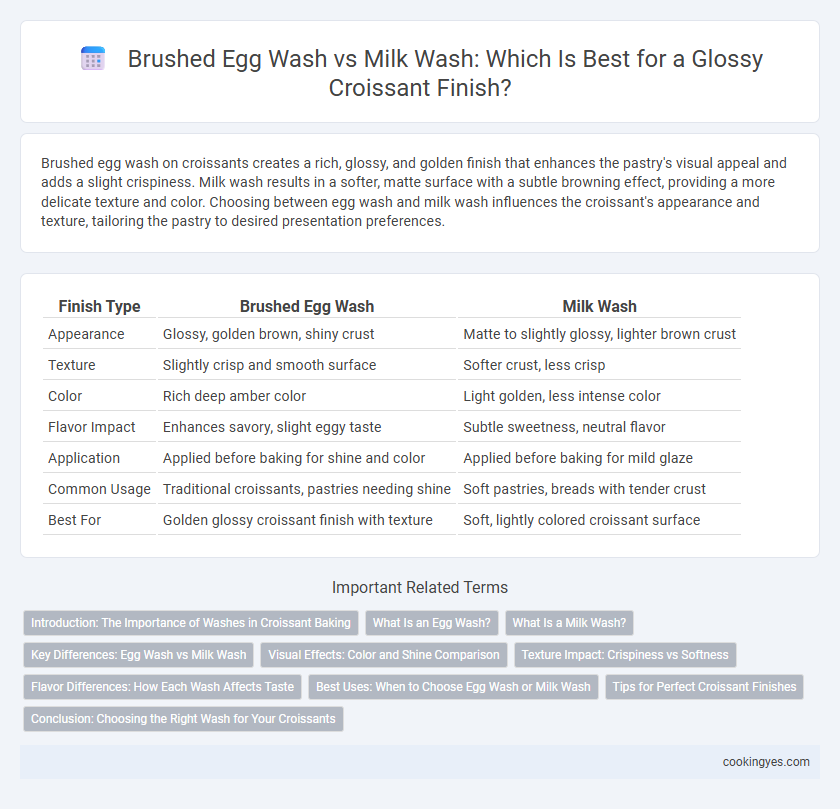Brushed egg wash on croissants creates a rich, glossy, and golden finish that enhances the pastry's visual appeal and adds a slight crispiness. Milk wash results in a softer, matte surface with a subtle browning effect, providing a more delicate texture and color. Choosing between egg wash and milk wash influences the croissant's appearance and texture, tailoring the pastry to desired presentation preferences.
Table of Comparison
| Finish Type | Brushed Egg Wash | Milk Wash |
|---|---|---|
| Appearance | Glossy, golden brown, shiny crust | Matte to slightly glossy, lighter brown crust |
| Texture | Slightly crisp and smooth surface | Softer crust, less crisp |
| Color | Rich deep amber color | Light golden, less intense color |
| Flavor Impact | Enhances savory, slight eggy taste | Subtle sweetness, neutral flavor |
| Application | Applied before baking for shine and color | Applied before baking for mild glaze |
| Common Usage | Traditional croissants, pastries needing shine | Soft pastries, breads with tender crust |
| Best For | Golden glossy croissant finish with texture | Soft, lightly colored croissant surface |
Introduction: The Importance of Washes in Croissant Baking
Egg wash enhances croissants with a glossy, golden-brown crust and a slight crispness, crucial for an appealing bakery finish. Milk wash provides a softer, matte finish with a tender texture, promoting a subtler browning effect. Selecting the appropriate wash impacts the croissant's visual appeal and texture, influencing the overall sensory experience.
What Is an Egg Wash?
An egg wash is a mixture of beaten eggs, often combined with water or milk, used to coat croissants before baking to achieve a glossy, golden finish. A brushed egg wash enhances color intensity and crispiness, while a milk wash yields a softer, matte crust with a subtle sheen. Choosing between egg and milk washes impacts the croissant's visual appeal and texture but not its flaky layers.
What Is a Milk Wash?
A milk wash, composed of milk applied to croissant dough before baking, enhances crust color and adds subtle sweetness and shine. Unlike brushed egg wash, which uses beaten eggs for a glossy, rich finish, milk wash results in a softer, matte appearance while still promoting browning through lactose content. This technique is favored for delicate pastries like croissants to achieve a tender crust with gentle coloration.
Key Differences: Egg Wash vs Milk Wash
Brushed egg wash on croissants creates a deeper golden-brown color and a glossy, crisp finish due to the protein and fat content in eggs, enhancing visual appeal and texture. Milk wash results in a softer, matte crust with a lighter golden hue, as the lactose caramelizes but lacks the protein that promotes browning and shine. Choosing between egg wash and milk wash depends on the desired combination of color, gloss, and crust texture in the final croissant.
Visual Effects: Color and Shine Comparison
Brushed egg wash creates a rich, golden-brown color with a glossy, reflective shine that enhances the croissant's crescent shape and flaky texture. Milk wash results in a softer, matte finish with a lighter, pale golden hue that emphasizes a more natural, rustic appearance. The choice between egg wash and milk wash directly affects the visual appeal and perceived freshness of the croissant crust.
Texture Impact: Crispiness vs Softness
Brushed egg wash on croissants creates a glossy, golden crust with enhanced crispiness due to the proteins and sugars caramelizing during baking. Milk wash, rich in lactose and fats, results in a softer, more tender finish with a subtle sheen and less crunch. Choosing egg wash prioritizes a crisp texture, while milk wash favors a delicate softness.
Flavor Differences: How Each Wash Affects Taste
Brushed egg wash on croissants creates a rich, savory flavor with a glossy, golden-brown finish that enhances the buttery layers. Milk wash produces a softer crust with a subtle sweetness and a tender texture, highlighting the croissant's delicate flavor profile. Choosing egg wash emphasizes a more pronounced, classic pastry taste, while milk wash favors a milder, creamier flavor experience.
Best Uses: When to Choose Egg Wash or Milk Wash
Brushed egg wash provides a rich, glossy, and deep golden finish ideal for croissants meant to showcase a traditional, flaky, and visually appealing crust. Milk wash results in a softer, matte sheen with a slightly lighter color, perfect for croissants intended for a more delicate, tender texture or when aiming for less shine. Choose egg wash for bakery displays or artisanal croissants and milk wash for softer, everyday pastries or when avoiding a heavy sheen.
Tips for Perfect Croissant Finishes
Brushed egg wash creates a glossy, golden-brown finish on croissants, enhancing both appearance and texture with a slight crispness, while milk wash delivers a softer, matte sheen and tender crust. For perfect croissant finishes, apply egg wash thinly and evenly before baking to avoid sogginess, and use cold wash to prevent dough from becoming sticky. Achieving an ideal balance between wash application and baking temperature is key to a visually appealing, delectably flaky croissant.
Conclusion: Choosing the Right Wash for Your Croissants
Brushed egg wash creates a rich, glossy, and golden-brown crust on croissants, enhancing both appearance and flavor with a slightly crisp finish. Milk wash results in a softer, matte surface with a tender texture, adding subtle sweetness and moisture. For a traditional bakery-quality croissant, egg wash is preferred for its shine and color, while milk wash suits those seeking a gentler, less shiny crust.
Brushed egg wash vs milk wash for croissant finish Infographic

 cookingyes.com
cookingyes.com